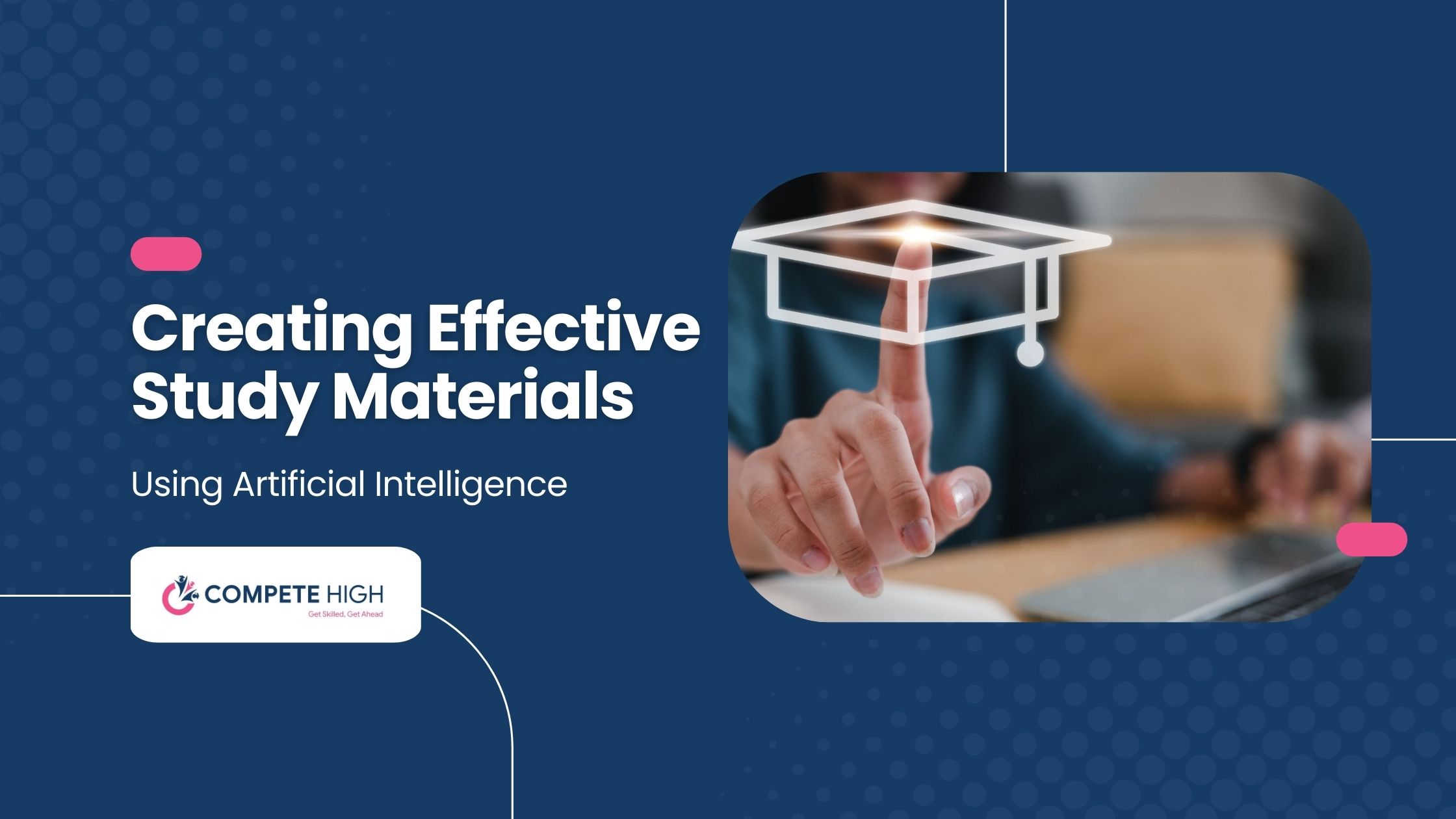
With the educational landscape changing incredibly fast, effective study materials are in demand more than ever. Students like to find new ways to study more effectively. And educators like to create informative, personalised, interesting and effective study materials for their students. Nowadays, the traditional way of making effective study materials is manual. Educators must take a lot of time and effort to create materials that can satisfy the needs of their students.
Yet, thanks to the advent of artificial intelligence (AI), that balance has been upended. AI is disrupting the process of material creation in education, opening new opportunities for automation, personalisation, and data-driven insights. AI can generate quizzes, summaries, flashcards, and study guides at a speed and scale that no human teacher could ever match. More importantly, it can generate these materials in ways that are tailored to each student’s needs, dynamically adapting content according to how they respond, their preferred learning style, and previous performance data.
In this blog, we will discuss how AI is revolutionising the creation of effective study materials, why it is so exciting, and what challenges are associated with creating AI-generated study materials for learning. We will also give some best practices for using AI most effectively so that any study materials that are created will be accurate, useful, and diverse.
Understanding AI in Education
Artificial intelligence (AI) is defined as the simulation of human intelligence in machines that are programmed to think and behave like humans and, to a greater extent, mimic cognitive processes associated with human minds. In education, AI is used in a variety of ways, ranging from automating administrative tasks such as marking, attendance monitoring, and timetabling to developing artificial intelligence (AI)-based platforms and programs for adaptive learning, immersive, personalised study materials, and AI-powered tutoring systems.
Another area where AI is having a big impact is the creation of educational content. Bots can be used to scan thousands of books, research papers, and course materials and generate summaries, quizzes, and interactive learning items. Similarly, bots can monitor patterns of student behaviour, such as how they interact with various types of effective study materials or what topics they struggle with, and use that information to tweak the content to optimise learning.
This capacity to create content on the fly and continually adjust to a learner’s needs is a key differentiator between AI-generated content and even the best human-generated content. With AI, students can get just the right level of scaffolding that can help them advance.
Benefits of Using AI to Create Study Materials
Study material creation could be greatly accelerated and improved by the use of AI due to the following reasons:
Personalisation and Adaptivity
The most immediate benefit of AI is that AI-enabled content can be tailored to the needs of the individual learner. In reality, each student learns differently, and AI can be used to personalise study content for learners. For example, AI can keep track of how much of a topic has been covered and adapt the content based on that information—for example, by automatically giving a student more practice when they are not yet comfortable with a particular concept.
This could be particularly useful in areas such as mathematics, in which all students might start by learning very similar concepts but then need different amounts of practice with specific topics, or in language learning, in which students may advance at different rates.
Adaptive learning platforms such as Smart Sparrow and Knewton, using artificial intelligence, are already changing the way students engage with a study book. Using algorithmic decision-making based on how a student is performing, the platform will change the difficulty of the content and offer more support or more challenges based on real-time data. This means that whether a learner is ahead or behind, AI will keep the student engaged at the pace and level needed to maximise their learning.
Furthermore, AI can also address a variety of learning styles. Some students learn better through visual aids, some through audio, and some via hands-on activities. AI can help recommend materials that cater to such learning styles so that every student is provided with resources that best suit their learning needs.
Efficiency and Time Saving
If you’re an educator trying to develop effective study materials from scratch—for example, when you have hundreds of students in a class and different students have different needs—it can be a very time-consuming process. AI tools can help to reduce that workload by automating the creation of study guides, quizzes, flashcards, and summaries.
For instance, there are tools such as Quizlet and Brainscape that enable users to enter raw data from textbooks or lecture notes and let the machine do the rest of the work, producing a study set of flashcards and quizzes. There are also tools such as Scribendi and Grammarly that incorporate AI into proofreading and editing to assist students and teachers in reviewing and cleaning up essays to make them neater and more error-free.
AI’s ability to process large amounts of text and extract key data can help to summarise textbooks, academic articles, and essays. Tools such as SummariseBot and Resoomer use natural language processing (NLP) algorithms to create shortened versions of a text, enabling students to review intricate topics in a fraction of the time it would take to read the original.
Furthermore, AI can support lesson planning and assessments. Edmodo, for example, is an AI platform that offers pre-designed quizzes, tests, and assignment templates that educators can use. AI can enable educators to spend more time teaching and less time preparing for class. This can be helpful for teachers who handle multiple classes or subjects.
Engagement and Interactive Learning
Not only does AI allow you to develop effective study materials more quickly or cost-effectively, it makes them more engaging for students. Interactive or immersive learning experiences are increasingly important in education, and AI-powered platforms are great at delivering that.
For example, game-like language-learning apps such as Duolingo use AI to provide personalised, gamified lessons that are dynamically adjusted to the learner’s level through immediate feedback, progress tracking, and lesson tailoring in areas in which the student may need to work harder on their learning experience.
Apart from gamification, AI could also be used to create interactive simulations and virtual environments. For instance, subjects such as science, engineering, and medicine could be studied using virtual labs that allow students to perform risk-free experiments in the virtual space. One existing example is a company called Labster, which offers virtual labs. This allows students to engage with the material in a way similar to the real-world experience and makes learning more interesting, especially for difficult concepts.
Furthermore, AI-empowered chatbots and virtual tutors can provide on-demand guidance to students. Chatbots such as Socratic, designed by Google, can answer questions across a wide range of topics and walk students through problem-solving processes. AI tutors can instantly help students overcome challenges and keep them on track.
Data-driven insights for improvement
One of its most useful powers is the way it can track and analyse student data, such as how students use study material. These insights can help students and teachers find productive ways to learn.
For example, smart learning management systems (LMS) such as Canvas and Blackboard collect data on how students interact with course content, quizzes, and assignments. Instructors can use this information to determine which topics are not understood well and to make changes to their approach. With these insights, instructors can then intervene and provide support to students who are struggling.
AI can also help students build up knowledge of how they learn. Coursera, for example, provides a lot of learning analytics to students, allowing them to track their progress over time and see their performance compared with overall cohorts. As the examples above have shown, this allows students to make decisions about how best to allocate their study time.
Moreover, AI systems can offer predictive analytics, helping teachers predict a student’s performance and identify those at risk. By analysing past data and trends, AI systems can determine which learners will likely not do well on an upcoming test and recommend interventions before they fall behind.
AI Tools for Creating Study Materials
There are numerous free AI-powered tools available to educators and students to create and optimise their studies; here are some of the best and most popular:
AI-Powered Text Summarization Tools
Summarising textbooks, even if they are dense and technical ones, or research papers, lecture notes, or other long-form web pages, is a very time-consuming process. Therefore, there’s a great demand for automatic text summary generation using natural language processing (NLP). Text-summarisation tools like TL/DR and Resoomer summarise textbooks, research papers, and lecture notes, and they can be very helpful for students preparing for exams or writing assignments. They don’t have to read the whole chapter but can scan through the summary.
This technology can be especially valuable for subjects such as law, medicine, and engineering, where the learning curve is steep and students often have to memorise large amounts of information. With AI summarization, students can learn the key concepts while saving time and avoiding the risk of forgetting important information.
Flashcard and Quiz Generators
Flashcards and quizzes are great for learning reinforcement and improving retention, but it’s tedious to design and grade them manually. That’s why AI platforms such as Quizlet and Brainscape have been designed to create flashcards and quizzes automatically based on course materials that a teacher or student has entered into the system. AI optimises the learning process by giving students the right questions to see at the right time based on their performance.
Quiz generators developed based on artificial intelligence can similarly adapt to the student’s progress, increasing the difficulty of the questions as the student’s score increases or returning to topics that the student struggled with earlier. Just as a human teacher would do, these adaptive quizzes will make sure that the student is never bored or left in the dark, ensuring that they stay engaged and retain information more easily.
Study planners and scheduling tools
Time management is a key competency for students, so MyStudyLife and Class Timetable is a great AI-powered study planner where students can create a personalised study timetable: they just need to log in and enter their learning goals, deadlines, and exam dates; the study planner will take into account personal preferences, study habits, and available time to suggest the best study plan to achieve the learning goals.
Likewise, an AI-powered study planner can help students see how much time they should spend on each subject and can even send reminders and notifications to nudge them in the right direction. What this means is that, when it comes to exam preparation, AI helps students manage time more effectively instead of making them do the same more quickly.
AI-driven Interactive Learning Platforms
Pearson’s Revel and Century Tech are examples of interactive learning platforms that use AI to offer individualised study materials and real-time feedback, providing students with multiple forms of learning content—videos, interactive assessments, and readings—that adapt to the student’s learning curve. By giving immediate feedback and adapting the difficulty of the content to the student’s progress, these platforms help students stay motivated.
Interactive learning platforms using AI enable students to do well in subjects such as maths, science, and language learning, which require personalised instruction and feedback in real time. This dynamic learning is enabling students to increase their confidence and do better.
Challenges of Using AI in Study Material Creation
Despite the advantages that AI provides in generating study material, it also comes with a few challenges for educators and students to address:
Bias in AI algorithms
Like many AI systems, such tools are trained on large data sets. They will, therefore, be susceptible to bias if those data sets also reflect bias. The biases of the AI system can then become reflected in whatever it generates, such as the effective study materials it produces. For instance, an AI that has been trained on a data set representing a single culture or demographic group is more likely to generate materials that don’t incorporate relevant views or stereotypes, leading to unequal learning outcomes for students.
As a result, developers of AI-powered teaching tools must diligently train their algorithms on wide-ranging data sets. Equally, educators should review the AI output for inclusivity and free of bias.
Dependence on Technology
While AI can make studying easier, students can become too dependent on AI. Suppose students rely on AI to give them answers or to create effective study materials. In that case, the students need to learn how to think critically and solve problems.
To minimise this risk, educators should encourage students to use AI tools as an adjunct to, rather than a substitute for, conventional modes of study. AI would be used to augment learning, not to replace it.
Privacy and Data Security Concerns
In most cases, such AI-based educational tools have access to a lot of data related to the performance of students, the patterns of their learning, and their interaction with study resources. While the data could be significant for personalising a student’s learning experience, it can have some implications around privacy and data security.
In the UK and Europe, laws such as the General Data Protection Regulation (GDPR) mandate that schools and other educational institutions maintain the privacy and security of student data. Institutions should collaborate with AI tool vendors to ensure that they are in line with such regulations before sharing data.
Best Practices for Creating Effective AI-Driven Study Materials
Based on these best practices, educators and students alike can make the most of AI in developing study guides.
Choosing the Right AI Tools
Not all such AI tools are created equal, however. Teachers may want to select platforms carefully to match specific educational goals, learning objectives, and intended uses. Robust features, data security, and positive reviews by educators and students are all important.
Educators should try out the AI resource to check that it works as expected and ask if it fulfils their needs for their learners; they could also ask students for their feedback on how effective the AI-created materials are and if they work for them.
Combining AI with Human Expertise
Although AI can automate many aspects of content creation, it cannot replace it. Educators bring experience, context, and critical thinking to the process of creating effective study materials; without them, content could be factually incorrect, inappropriate for the intended audience, or at odds with academic standards.
An educator should review AI-generated study materials to make sure they suit the curriculum and don’t contain any errors. This way, AI’s efficiency can be used in conjunction with human expertise to create effective study materials that will benefit individual learners.
Continuous Monitoring and Feedback
While AI systems learn and improve over time, someone must regularly check their performance and provide feedback to developers on how they could improve. Educators should regularly review the performance of AI learning tools and provide feedback to developers on how they could improve.
Students could also be invited to provide feedback on the AI-produced study materials they read. This would allow developers of AI tools to get input from both instructors and learners and to refine further the algorithms that they employ for generating effective study materials.
Ensuring Inclusivity in AI-Generated Content
Thirdly, AI-generated study materials must be equitable and accessible for all students, regardless of their background or learning style. Teachers should ensure that the AI technologies they use contribute to diversity and inclusion by generating content that reflects a wide range of perspectives and learning needs.
Beyond looking for bias, educators should also make sure that the content is accessible to students with disabilities. If it includes non-textual elements, it should come with alternative formats for students who are blind or low-vision and for those who are deaf or hard of hearing; if it incorporates interactivity, it should be compatible with all the assistive technologies that students might need to use.
Conclusion
When AI-based tools are used to create effective study materials, they might save time for teachers while making content more adaptable and relevant. However, this potential can only come to fruition if teachers and students are cognizant of the challenges posed by the use of AI, such as algorithmic bias and systemic over-reliance on technology. Data privacy also needs to be addressed.
As long as teachers follow best practices—use the right AI tools, combine AI with human expertise, and create inclusive content—AI could be used to create effective study materials that will further enhance learning. AI will likely become increasingly important in the education sector as the technology evolves.
For now, we should regard AI as a machine that can aid human learning—an innovative piece of educational apparatus that, if used well, can enhance the curriculum’s accessibility and effectiveness for every student.










